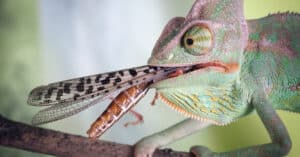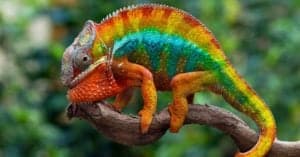Over 5,000 species of lizards roam the planet these days. They range from minuscule lizards that fit on your fingertip to vast beasts that can chase down deer and even human beings. Among the most interesting species of these reptiles are chameleons, creatures that have a wide range of colors, unique features, and subspecies. However, chameleons are a very distinct type of lizard, and it can be hard to tell them apart. Take a closer look at the chameleon vs lizard and see how these two creatures measure up to one another.
Comparing a Chameleon and a Lizard

| Chameleon | Lizard | |
| Size | Weight: 0.2lbs-4.4lbs Length: 1.5ft-2ft | Weight: varies, with some as low as 0.02lbs and others over 600lbs! Length: 2-4ft on average, with many larger species in existence. |
| Location | Africa and parts of Asia | – All over the world except for Antarctica – Habitats include rain forests as well as arid deserts |
| Tail | – Prehensile tails that help grab branches | – Most lizard species have long, thin tails that they use for defense – Some species, like the alligator lizards, have prehensile tails |
| Eyes | – Conical eyelid that protrudes from the face and helps them see in all directions – Each eye can rotate and move in two directions at once, allowing them to focus on different objects – Great field of vision | – Good vision, especially in diurnal species – Many have eyes on the side of their heads for a wide field of vision |
| Tongue | Extrudable tongue that helps them grab prey | Have short, round tongues or they may have forked tongues like the Komodo dragon |
| Reproduction | May give live birth or lay eggs | Typically, lizards only lay eggs |
| Lifespan | 4-8 years | 2-30 years |
The 7 Key Differences Between Chameleon vs Lizard
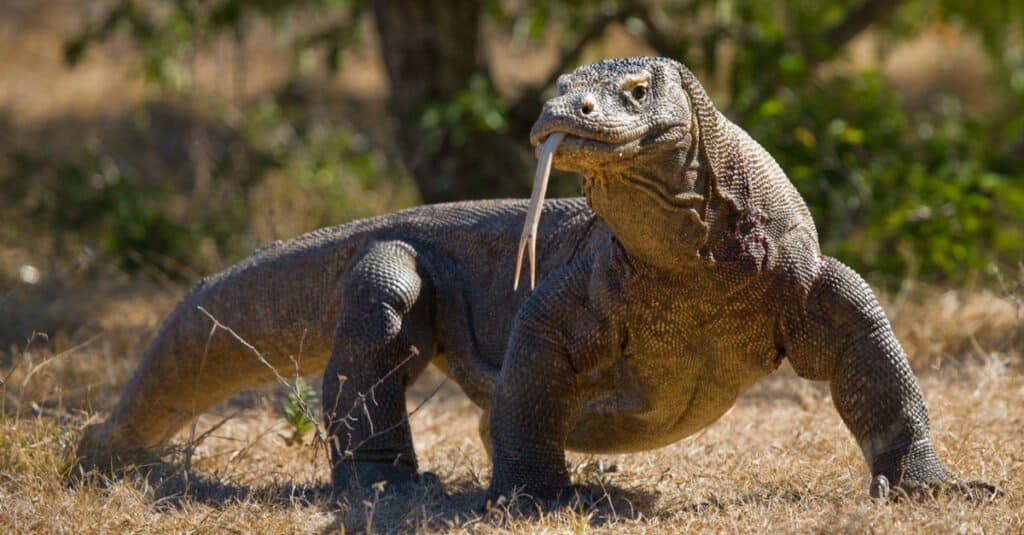
Chameleons are relatively small creatures, but many other lizards are very large.
©GUDKOV ANDREY/Shutterstock.com
The greatest differences between a chameleon and a lizard are their tails, eyes, and tongues. Chameleons are known for their unique prehensile tails, and they are one of the few reptiles that possess them.
Lizards tend to have recessed eyes that sit normally in their skull rather than protrude from their face. Chameleons have eyes that protrude from their head inside of a conical eyelid. They can also use their unique eyes to look off in two different directions and focus on different objects.
Lastly, most lizards have a short, round tongue, but chameleons have long, extrudable tongues that they used to capture and eat prey. These major differences between the creatures are helpful in identifying a mere lizard versus a chameleon.
Chameleon vs Lizard: Size
Lizards are larger than chameleons on average. Several species of chameleons rank among the smallest lizards in existence, with some measuring so small that they fit on a human’s fingertip. Others can measure up to 2ft long and weigh 4.4.lbs. Those are about the same size as the average lizards, including iguanas.
However, some lizards can reach much larger sizes. Specifically, the monitor lizard and Komodo dragon are two very large reptiles that grow up 400lbs and are about 8.5ft long.
Chameleon vs Lizard: Location
Chameleons only live in Africa and parts of Asia, but they have been shipped around the world as pets. Lizards live all throughout the world except for Antarctica, and they have a variety of habitats that include rain forests and deserts.
You can find a species of lizard just about anywhere, but chameleons are far less widespread.
Chameleon vs Lizard: Tail
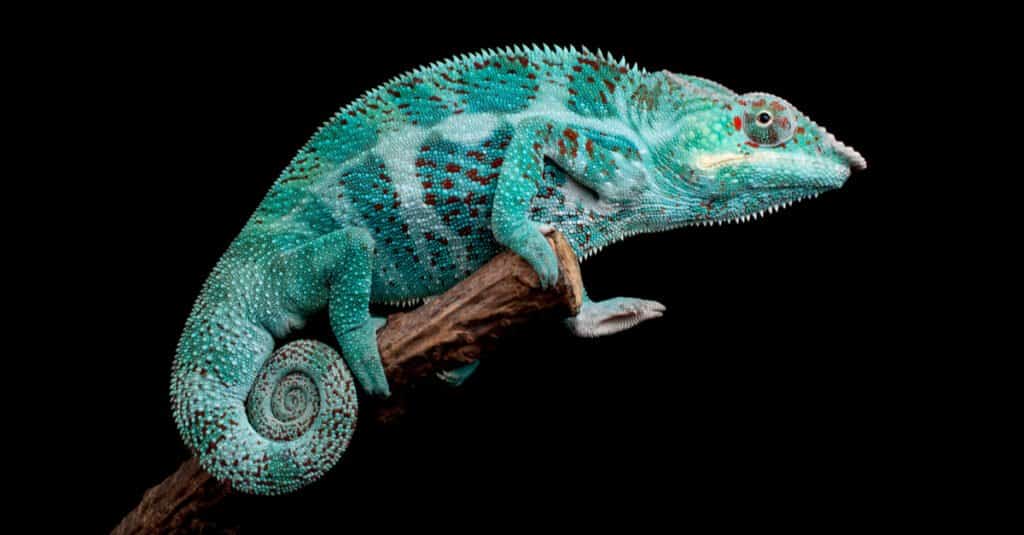
When they’re not grabbing anything, chameleon’s tails are often curled up
©Ferdy Timmerman/Shutterstock.com
Chameleons have prehensile tails that help them grab onto branches and other items, but most lizards do not have prehensile tails. Instead, many lizards, like the iguana and Komodo dragon, have long, thin tails that they use for smacking foes or even swimming.
Some lizards do have prehensile tails, like the alligator lizard, but they are exceedingly rare within the thousands of species of lizards that exist in the world. Chameleons tend to make their tails curl up while they’re walking and resting.
Chameleon vs Lizard: Eyes
Chameleons have unusual eyes that protrude from their heads and can focus on two different objects in two different directions at once. However, most lizards have eyes that are more typical and recessed in their heads.
Chameleons’ eyes are also unusual because their conical eyelids extend so far out of their heads. Their eyes are one of the hallmark signs that the lizard a person is looking at is a chameleon rather than another reptile.
Chameleon vs Lizard: Tongue

Chameleon’s have extrudable tongues that help them catch prey.
©Lauren Suryanata/Shutterstock.com
Chameleons have extrudable tongues that they essentially propel from their mouths to trap and catch prey. Their tongues can be about as long as their bodies in some cases. That makes chameleons very unusual hunters in that they don’t have to get directly on top of their foes to eat them.
Most lizards have short, round tongues. However, a few lizards, like the Komodo dragon, have forked tongues that resemble snakes’ tongues.
Chameleon vs Lizard: Reproduction
Most chameleons lay eggs for reproduction, but a few species can give birth. The Jackson’s chameleon keeps the eggs internally until the young are developed enough to be introduced into the world.
The vast majority of lizards do not give live birth to their young. Just about every other lizard in the world lays eggs in various types of nests.
Chameleon vs Lizard: Lifespan
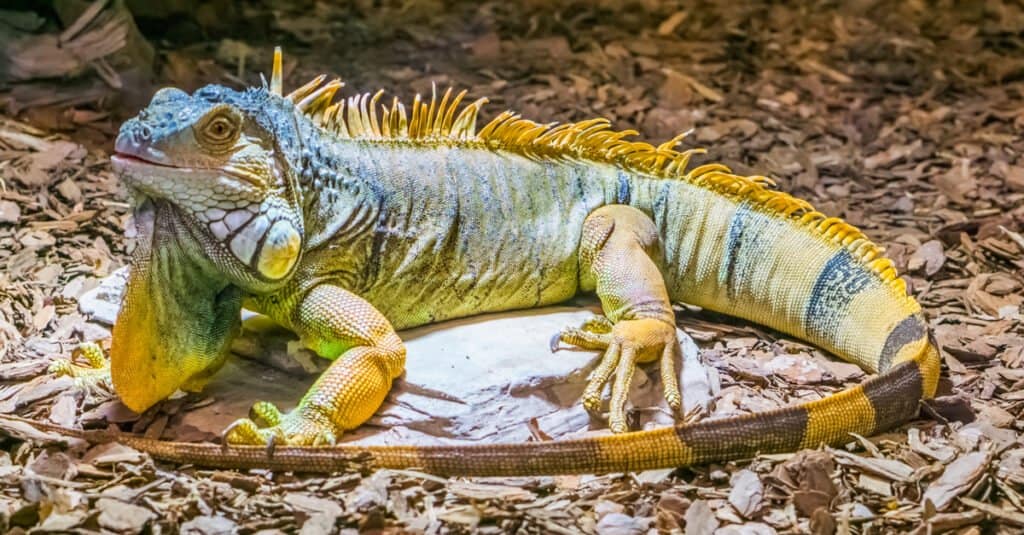
Iguanas are reptiles that can live over 40 years
©Charlotte Bleijenberg/Shutterstock.com
Chameleons are some of the most short-lived lizards in the world. In fact, the Labord’s Chameleon spends more time as an embryo than an adult. They take 8-9 months to develop before they hatch, and then they only live for about 4-6 months before they die.
However, many other species of lizard are exceptionally long-lived. Some iguanas have lived over 40 years of age in captivity. Not all chameleons are as short-lived as the Labord’s Chameleon, but they live between 4-8 years in most cases, and they don’t do particularly well in captivity.
Chameleons are an interesting species of lizard, and they deviate from other members of their family in many ways. If you’re ever trying to tell these reptiles apart, it’s best to look at their eyes, tails, and tongue. Those physical elements should help you identify whether you are looking at a chameleon or another reptile right away!
The photo featured at the top of this post is © Lauren Suryanata/Shutterstock.com
Thank you for reading! Have some feedback for us? Contact the AZ Animals editorial team.



